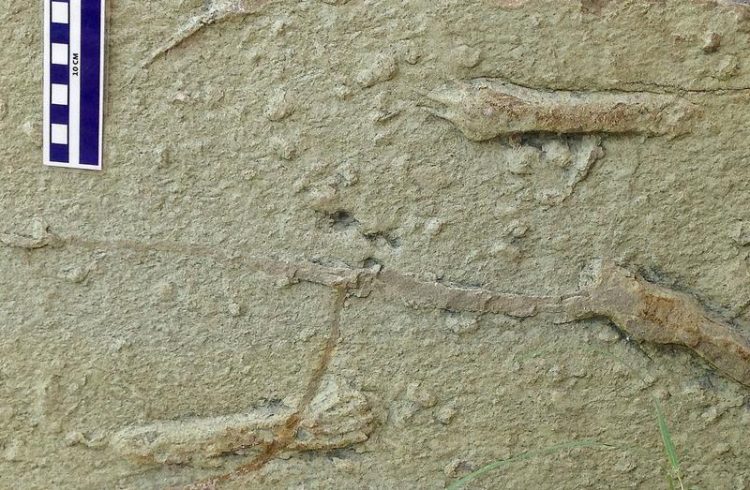New Indications of Gradual Decline of Dinosaurs before the End of the Cretaceous Period

Prints of azhdharchidea Pterosaurs in a sandstone of the Cretaceous Period. Location: Rancho San Francisco near Paredon, northeastern Mexico. Photo: Wolfgang Stinnesbeck
While conducting paleontological research in northeastern Mexico, the scientists came upon sedimentary rock deposited toward the end of the Cretaceous Period that evidenced an enormous diversity of fossils, including the tracks of birds, dinosaurs and pterosaurs.
“Most of the imprints come from at least five different species of birds; dinosaur tracks, however, are rare. Only a single footprint comes from a predatory dinosaur,” explains Prof. Stinnesbeck. The finds therefore indicate a gradual decline of the dinosaurs with a simultaneous increase in the diversity of birds even before the end of the Cretaceous Period.
“Until now, it was generally assumed that the dinosaurs died out first and bird species diversified afterward,” states the researcher. “Our data, however, substantiate the theory that birds ascended before dinosaurs became extinct.”
Fossil analysis also showed that the decline of the dinosaurs occurred gradually, with probably only a few species surviving until the end of the Cretaceous Period. The extinction of the dinosaurs is therefore not – as science frequently assumes – due to the impact of the Chicxulub asteroid that struck the earth more than 65 million years ago.
“For most of the dinosaurs and pterosaurs, this strike no longer had any effect,” explains Prof. Stinnesbeck. Even the group of cephalopods, the so-called ammonites, was not annihilated by the asteroid strike at the end of the Cretaceous Period. According to Prof. Stinnesbeck, fossil finds of the Sphenodiscus pleurisepta ammonite show their successive decline beyond the Cretaceous Period.
“The effects of the Chicxulub impact were therefore not the cause of a global mass extinction, which probably came about considerably less catastrophically than previously assumed,” states the Heidelberg researcher.
Original publication:
W. Stinnesbeck et al.: Theropod, avian, pterosaur, and arthropod tracks from the uppermost Cretaceous Las Encinas Formation, Coahuila, northeastern Mexico, and their significance for the end-Cretaceous mass extinction. Geological Society of America Bulletin (Vol. 129, No. 3-4), doi: 10.1130/B31554.1
Contact:
Prof. Dr. Wolfgang Stinnesbeck
Institute of Earth Sciences
Phone +49 6221 54-6057
wolfgang.stinnesbeck@geow.uni-heidelberg.de
Communications and Marketing
Press Office
Phone +49 6221 54-2311
presse@rektorat.uni-heidelberg.de
http://www.geow.uni-heidelberg.de/forschungsgruppen/palaeontologie/
Media Contact
All latest news from the category: Earth Sciences
Earth Sciences (also referred to as Geosciences), which deals with basic issues surrounding our planet, plays a vital role in the area of energy and raw materials supply.
Earth Sciences comprises subjects such as geology, geography, geological informatics, paleontology, mineralogy, petrography, crystallography, geophysics, geodesy, glaciology, cartography, photogrammetry, meteorology and seismology, early-warning systems, earthquake research and polar research.
Newest articles

Webb captures top of iconic horsehead nebula in unprecedented detail
NASA’s James Webb Space Telescope has captured the sharpest infrared images to date of a zoomed-in portion of one of the most distinctive objects in our skies, the Horsehead Nebula….

Cost-effective, high-capacity, and cyclable lithium-ion battery cathodes
Charge-recharge cycling of lithium-superrich iron oxide, a cost-effective and high-capacity cathode for new-generation lithium-ion batteries, can be greatly improved by doping with readily available mineral elements. The energy capacity and…

Novel genetic plant regeneration approach
…without the application of phytohormones. Researchers develop a novel plant regeneration approach by modulating the expression of genes that control plant cell differentiation. For ages now, plants have been the…





















